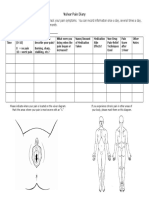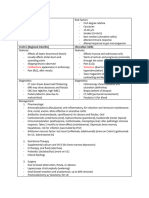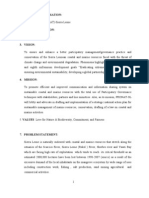0 ratings0% found this document useful (0 votes)
36 viewsDate / /: Impacts-Of-Cancer/pain
Date / /: Impacts-Of-Cancer/pain
Uploaded by
AnestilThis pain diary is intended to help patients record information about their pain to discuss with doctors and nurses. It includes spaces to note the date, location of pain, description of pain, pain level on a scale of 1-10, impact on daily activities, pain treatments, and factors that make the pain better or worse. The diary can be photocopied and used as needed to effectively communicate about pain.
Copyright:
© All Rights Reserved
Available Formats
Download as PDF, TXT or read online from Scribd
Date / /: Impacts-Of-Cancer/pain
Date / /: Impacts-Of-Cancer/pain
Uploaded by
Anestil0 ratings0% found this document useful (0 votes)
36 views2 pagesThis pain diary is intended to help patients record information about their pain to discuss with doctors and nurses. It includes spaces to note the date, location of pain, description of pain, pain level on a scale of 1-10, impact on daily activities, pain treatments, and factors that make the pain better or worse. The diary can be photocopied and used as needed to effectively communicate about pain.
Original Description:
Original Title
1506_10061
Copyright
© © All Rights Reserved
Available Formats
PDF, TXT or read online from Scribd
Share this document
Did you find this document useful?
Is this content inappropriate?
This pain diary is intended to help patients record information about their pain to discuss with doctors and nurses. It includes spaces to note the date, location of pain, description of pain, pain level on a scale of 1-10, impact on daily activities, pain treatments, and factors that make the pain better or worse. The diary can be photocopied and used as needed to effectively communicate about pain.
Copyright:
© All Rights Reserved
Available Formats
Download as PDF, TXT or read online from Scribd
Download as pdf or txt
0 ratings0% found this document useful (0 votes)
36 views2 pagesDate / /: Impacts-Of-Cancer/pain
Date / /: Impacts-Of-Cancer/pain
Uploaded by
AnestilThis pain diary is intended to help patients record information about their pain to discuss with doctors and nurses. It includes spaces to note the date, location of pain, description of pain, pain level on a scale of 1-10, impact on daily activities, pain treatments, and factors that make the pain better or worse. The diary can be photocopied and used as needed to effectively communicate about pain.
Copyright:
© All Rights Reserved
Available Formats
Download as PDF, TXT or read online from Scribd
Download as pdf or txt
You are on page 1of 2
Keeping a record of the pain will help you discuss it with your You can print more copies
e copies of this diary from our website at
doctors and nurses. Photocopy this diary before you fill it in so macmillan.org.uk/cancer-information-and-support/
that you can use it as often as you need to. If the pain is in more impacts-of-cancer/pain
than one place, you may want to use an extra copy of this diary. Date / /
Date Where is What is the Level of pain Does the pain What medicines What makes What makes
and time the pain? pain like? (0=no pain stop you doing and treatments the pain the pain
10=severe) daily activities, have you used? better? worse?
or sleeping?
You can use diagrams like the one below to mark where your
pain is. If you have more than one pain, label them 1, 2, 3,
and so on (with 1 being the pain that upsets you most).
Pain DiArY
Where is the pain?
Is it in one part of your
body or in more than
one place?
You can use the diagrams
on the right to mark where
How to use your pain diary
your pain is. You may want to pull out this pain diary and photocopy it, so you
can use it more than once. Remember to photocopy both sides.
If you have more than
one area of pain, you may 1. Start by recording when you feel the pain. There is space to
want to label them A, B, C note the date and time. You can fill in the diary as often as you
and so on (with A being need to. If the pain is not well-controlled, you may want to fill it
the pain that upsets you in every 1 to 2 hours. If the pain is better controlled, you can fill
the most). it in every 4 to 6 hours.
front back
front back 2. Record where the pain is in your body. You can use the
What is the pain like? diagrams on the back. It could be in one area or in lots of areas.
We have also
Use any of the following included
words this diagram
that best describeon the pain:
your back page of
the pain diary (in the centre of this booklet). There is more 3. Describe what the pain feels like. You could use the words on
information about keeping a pain diary on pages 12–13. the back to help you.
• aching • dragging • numb • smarting
• biting • dull • penetrating • sore
• blunt • excruciating • piercing • spreading 4. Rate the level of pain on a scale of 0 to 10, where 0 means
• burning MAC11670_pain_E10_p08_reprint_SH_20151125.indd
• frightful • pins and • stabbing no pain and 10 means severe pain.
10 25/11/2015 16:02:13
• cold • gnawing needles • stinging
• comes • hot • pricking • tender 5. Record whether the pain stops you from sleeping or doing
and goes • intense • radiating • throbbing any other daily activities.
• constant • nagging • scratchy • tingling
• crushing • nauseating • sharp • tiring 6. Write down the medicines you have used, and any other
• cutting • niggling • shooting • unbearable. treatments or therapies that have helped manage the pain.
Record anything that made the pain better or worse.
Numbered pain scale All of this information will help you and your healthcare team
How bad is the pain? If you measured it on a scale of 0 to 10, find the best pain control methods for you.
how would you rate it? 0 is no pain and 10 is the worst pain you
have ever had.
You might also like
- PainScale NeckDocument2 pagesPainScale NecknovaNo ratings yet
- ATI Pain ManagementDocument5 pagesATI Pain Managementisapatrick8126No ratings yet
- P 17 Must Be Perforated: Age Pain AssessmentDocument2 pagesP 17 Must Be Perforated: Age Pain AssessmentJoko SantosoNo ratings yet
- 2A - Zahirah Rahmadian Budiman - PROBLEMS WITH PAINDocument5 pages2A - Zahirah Rahmadian Budiman - PROBLEMS WITH PAINZahirah BudimanNo ratings yet
- My Pain DiaryDocument2 pagesMy Pain DiaryeryxspNo ratings yet
- English (7) For NursingDocument8 pagesEnglish (7) For NursingSyahlu DamayantiiNo ratings yet
- A. Pain Relief A. Match The Types of Pain Relief (1-6) To The Definitions (A-F)Document2 pagesA. Pain Relief A. Match The Types of Pain Relief (1-6) To The Definitions (A-F)Tania sabillaNo ratings yet
- Anamnesis (3) 36739Document9 pagesAnamnesis (3) 36739May KimNo ratings yet
- Pain ScaleDocument5 pagesPain ScaleK Jayakumar KandasamyNo ratings yet
- Describing Pain - Nursing 23-24-2Document4 pagesDescribing Pain - Nursing 23-24-2silvialopezgarcia15No ratings yet
- Widya Kusumaningrum (1902114) 2C Tugas Bhs. Inggris Asking The Dimensions of SymptomDocument4 pagesWidya Kusumaningrum (1902114) 2C Tugas Bhs. Inggris Asking The Dimensions of SymptomWidya KusumaningrumNo ratings yet
- Caring For Terminally Ill PatientDocument6 pagesCaring For Terminally Ill Patientanugrah bagus PutrantoNo ratings yet
- English For The Professional Nurse: Useful ExpressionsDocument3 pagesEnglish For The Professional Nurse: Useful ExpressionsLestari RahayuNo ratings yet
- The SPIN-screen: The North West London HospitalsDocument5 pagesThe SPIN-screen: The North West London HospitalsgabrimarteNo ratings yet
- Mild PainDocument5 pagesMild PainOktri SuryaniNo ratings yet
- Unit 2Document5 pagesUnit 2Galuh ParameswariNo ratings yet
- PainScale MigraineDocument2 pagesPainScale MigraineBarbara Rebeca De Macedo PinheiroNo ratings yet
- AssessmentDocument3 pagesAssessmentAndrew MidaNo ratings yet
- Pain Assessment & Measurement GuidelinesDocument12 pagesPain Assessment & Measurement GuidelinesFatamorgana AbdullahNo ratings yet
- The Brief Pain Inventory: Pain Research Group All Rights ReservedDocument8 pagesThe Brief Pain Inventory: Pain Research Group All Rights ReservedTira Hamdillah SkripsaNo ratings yet
- New Patient Spine PacketDocument16 pagesNew Patient Spine PacketDebra SmithNo ratings yet
- Ensign 2.4 Pain ActivityDocument4 pagesEnsign 2.4 Pain Activitydanaensign100% (1)
- Unit 4 Pain AssessmentDocument5 pagesUnit 4 Pain AssessmentAdellia ZahwaNo ratings yet
- Pain AssessmentDocument18 pagesPain Assessmentwegow897No ratings yet
- Andi Rara Pramei (70600116043) Dan Mufidah (70600116032)Document3 pagesAndi Rara Pramei (70600116043) Dan Mufidah (70600116032)rara prameiNo ratings yet
- 3 Peran Perawat Dalam Managemen Nyeri-1Document55 pages3 Peran Perawat Dalam Managemen Nyeri-1Anonymous PBDr0ONo ratings yet
- Medical Vocabulary Describing Sign N SimptomDocument21 pagesMedical Vocabulary Describing Sign N SimptomJessica KarinaNo ratings yet
- InfoSheet Pain AssessmentDocument3 pagesInfoSheet Pain AssessmentSarahTubeNo ratings yet
- Vulvar Pain Diary: Date of Last Menstrual PeriodDocument1 pageVulvar Pain Diary: Date of Last Menstrual PeriodMihaela NNo ratings yet
- Pain Assessment and ManagementDocument32 pagesPain Assessment and ManagementtmmrsptlnNo ratings yet
- 4th QTR Oct Nov DecDocument4 pages4th QTR Oct Nov DecJodieLynNo ratings yet
- Nick-Ortner TWS2014 DigiWorkbookDocument12 pagesNick-Ortner TWS2014 DigiWorkbookCristian Pop100% (4)
- 2020 Green Acute and Chronic Pain InjuryDocument4 pages2020 Green Acute and Chronic Pain InjuryRebecca KnightNo ratings yet
- Pain Assessment Scales PDFDocument10 pagesPain Assessment Scales PDFArio Wahyu PamungkasNo ratings yet
- Pain Assessment in Older Adults Post Viewing ReportDocument2 pagesPain Assessment in Older Adults Post Viewing ReportLiam HenryNo ratings yet
- Pain Scale Chart: 1 To 10 LevelsDocument3 pagesPain Scale Chart: 1 To 10 LevelsAthena Irish LastimosaNo ratings yet
- A Simple Guide to Pain Management, Diagnosis, Treatment and Related ConditionsFrom EverandA Simple Guide to Pain Management, Diagnosis, Treatment and Related ConditionsNo ratings yet
- Final Pain Education Tool OrangeDocument2 pagesFinal Pain Education Tool Orangeapi-244230664No ratings yet
- Reading 7Document2 pagesReading 7Cathy Mae MacahibagNo ratings yet
- Pain AssessmentDocument15 pagesPain AssessmentAvash ZhaNo ratings yet
- Problems With PainDocument3 pagesProblems With PainMayanda UtamiNo ratings yet
- Chapter - Pain Assessment and ManagementDocument3 pagesChapter - Pain Assessment and ManagementrxNo ratings yet
- PainDocument42 pagesPainIkbal MaulanaNo ratings yet
- Chronic Pain - Self-Help GuideDocument18 pagesChronic Pain - Self-Help GuideuserdlNo ratings yet
- Escala de DorDocument2 pagesEscala de DorRaniery CarvalhoNo ratings yet
- Introduction To Pelvic Pain 2019Document20 pagesIntroduction To Pelvic Pain 2019MrEnttNo ratings yet
- Acspc 046379Document84 pagesAcspc 046379Екатерина КостюкNo ratings yet
- Living With Pain (54426) PDFDocument71 pagesLiving With Pain (54426) PDFPartapNo ratings yet
- Lesson 2 SummaryDocument15 pagesLesson 2 SummarySarah SmithNo ratings yet
- SeizurediaryA4versionMay2019 PDFDocument8 pagesSeizurediaryA4versionMay2019 PDFMegha JainNo ratings yet
- Lesson 3 SummaryDocument18 pagesLesson 3 SummarySarah SmithNo ratings yet
- Using The Pain Scale Specialists Hospital Shreveport 2Document1 pageUsing The Pain Scale Specialists Hospital Shreveport 2ubonthNo ratings yet
- How To Be Mindful of Physical Pain: Step 1: Examining Pain and Tension in The BodyDocument3 pagesHow To Be Mindful of Physical Pain: Step 1: Examining Pain and Tension in The BodyTereNo ratings yet
- Parts of The Body & Health Problems: Session 6Document9 pagesParts of The Body & Health Problems: Session 6Redan Oi Fals ManiaNo ratings yet
- Name: Putri Dwi Handayani Reg. No.: P07520117041 Class: 3A Prodi DIII KeperawatanDocument5 pagesName: Putri Dwi Handayani Reg. No.: P07520117041 Class: 3A Prodi DIII KeperawatanPutri Dwi HandayaniNo ratings yet
- Coaching Notes Math 2Document221 pagesCoaching Notes Math 2nathaniel villanuevaNo ratings yet
- Scribe Test 2 Skeu 3043 Network and Signal SystemDocument7 pagesScribe Test 2 Skeu 3043 Network and Signal SystemkhairulNo ratings yet
- Boq Hydrant DumaiDocument7 pagesBoq Hydrant DumaigengmitraNo ratings yet
- GASTROINTESTINALDocument9 pagesGASTROINTESTINALjsreyes.402No ratings yet
- TOS in Pre-CalculusDocument1 pageTOS in Pre-CalculusJonathan OlegarioNo ratings yet
- PRONAT - Sierra Leone Project Proposal-ReviewedDocument17 pagesPRONAT - Sierra Leone Project Proposal-ReviewedMohamed Albert TarawallieNo ratings yet
- UGRD-CPE6300A Digital Electronics 2 ThreeDocument8 pagesUGRD-CPE6300A Digital Electronics 2 ThreeMER HANNo ratings yet
- 4161 758 104 en PDFDocument34 pages4161 758 104 en PDFhurmakmuhNo ratings yet
- Jadual Masa Bersemuka Teori Dan Amali Ee-320-3:2012Document4 pagesJadual Masa Bersemuka Teori Dan Amali Ee-320-3:2012Siva 93No ratings yet
- BCT-Syllabus-1st-Year-1st-Part (1) - UnknownDocument22 pagesBCT-Syllabus-1st-Year-1st-Part (1) - Unknownishanpokhrel16No ratings yet
- Syllabus For A Course On The EmotionsDocument3 pagesSyllabus For A Course On The EmotionsAleksandarNo ratings yet
- 26 10 2023 Handwritten NotesDocument17 pages26 10 2023 Handwritten NotesSahana ManjunathNo ratings yet
- Alpha Times, T.Nagar 04 October, 2009Document8 pagesAlpha Times, T.Nagar 04 October, 2009S. RaghunathanNo ratings yet
- Bakeshop Production: Basic Principles and IngredientsDocument19 pagesBakeshop Production: Basic Principles and IngredientsDYNATALIE DELICIOUSNo ratings yet
- Perancangan Turbin Angin Vertikal Savonius Sebagai Sumber EnergyDocument22 pagesPerancangan Turbin Angin Vertikal Savonius Sebagai Sumber EnergySafrul ImanNo ratings yet
- 2015-21 October-Isotope Maker A Matlab Program For Isotopic Data ReductionDocument7 pages2015-21 October-Isotope Maker A Matlab Program For Isotopic Data ReductionMuhammad Fathuraman PringgatamaNo ratings yet
- Mayon VolcanoDocument14 pagesMayon Volcanobigbang theoryNo ratings yet
- Reet PaperDocument67 pagesReet PaperSaraswati DeviNo ratings yet
- TOM-II Lab ManualDocument41 pagesTOM-II Lab ManualAli UsmanNo ratings yet
- Depreciation ActivityDocument4 pagesDepreciation ActivityAngelica PagaduanNo ratings yet
- Alstom SASDocument3 pagesAlstom SASShamim AbbasNo ratings yet
- Polyphenols As Natural Antioxidants in Cosmetics ApplicationsDocument5 pagesPolyphenols As Natural Antioxidants in Cosmetics ApplicationsRebek EscutiaNo ratings yet
- Simulation in Mobile Hydraulics: CostsDocument13 pagesSimulation in Mobile Hydraulics: CostsxxshNo ratings yet
- .Bionic Eye A New InventionDocument4 pages.Bionic Eye A New InventionSharadhiNo ratings yet
- DEUTZ PowerSolutions PDFDocument9 pagesDEUTZ PowerSolutions PDFAli ButtNo ratings yet
- Hammers and HighDocument3 pagesHammers and HighAyman HussienNo ratings yet
- 8x4M P10 Outdoor Advertising Led Display SolutionDocument23 pages8x4M P10 Outdoor Advertising Led Display SolutionArifin SaniNo ratings yet
- Operation and Maintenance Training Manual For Sand Filter Red Line North Elevated and at GradeDocument55 pagesOperation and Maintenance Training Manual For Sand Filter Red Line North Elevated and at GradeAdnan AttishNo ratings yet
- Samsung Front Load WasherDocument56 pagesSamsung Front Load Washerbear65No ratings yet
- Ayya VaikundarDocument6 pagesAyya VaikundarRuban RNo ratings yet

























































































